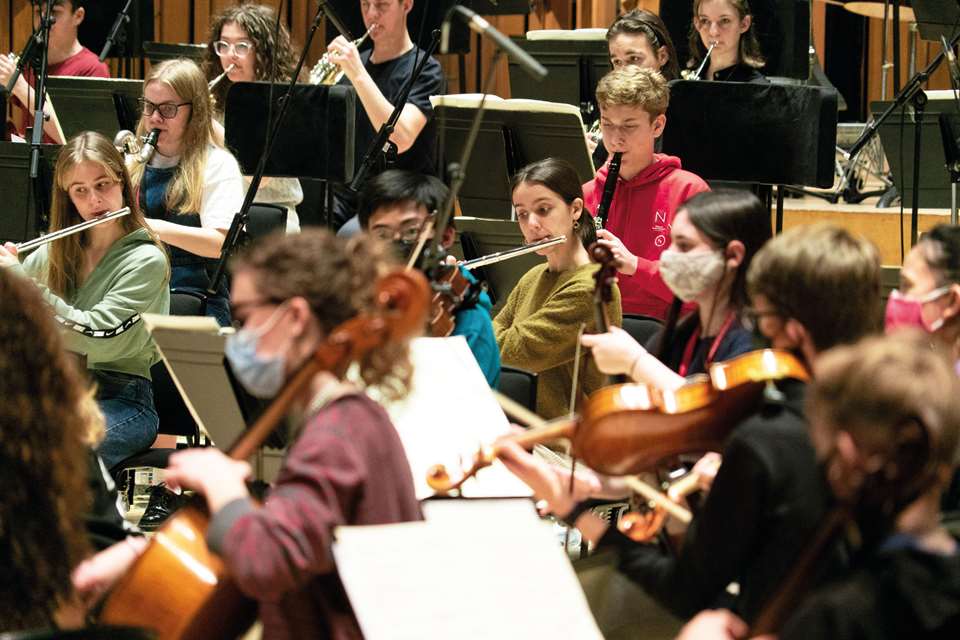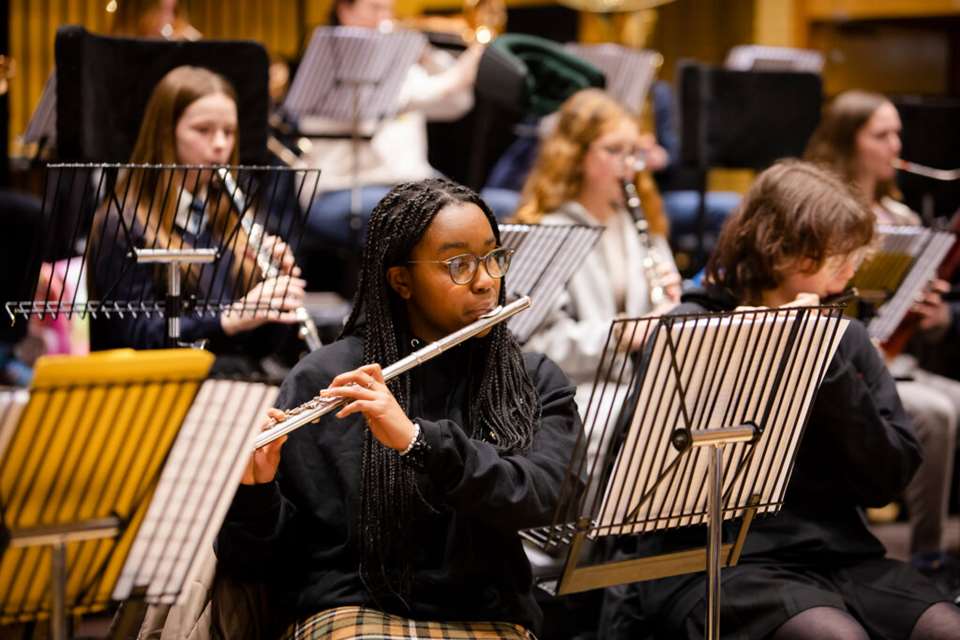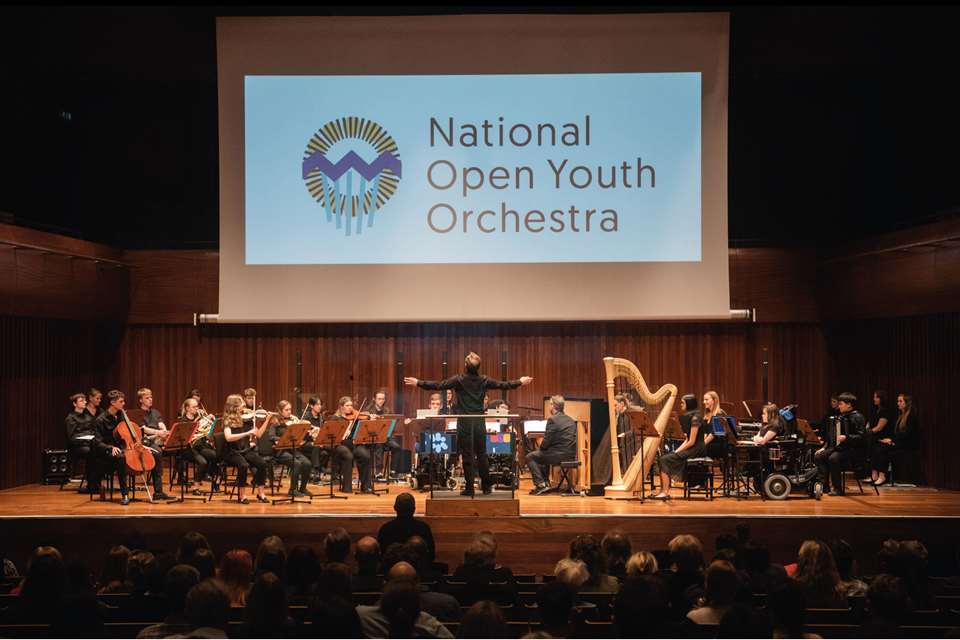Philharmonia Fantastique: Mason Bates on creating a new 'guide to the orchestra'
Harriet Richards
Tuesday, November 1, 2022
Philharmonia Fantastique is a new work that takes the ‘guide to the orchestra’ genre to a whole new level. Composer and DJ Mason Bates speaks to Harriet Richards about the creative team's mission-based approach to the project.

If you were to come up with a fresh take on The Young Person's Guide to the Orchestra or Fantasia, what would you include? An animated film – almost certainly. A classical/acoustic-electronic mix, perhaps? A genderless, ageless protagonist able to zip inside instruments, taking the audience with them? Maybe a focus on the orchestra as interactive technology, challenging the ‘science vs arts’ rhetoric. What about an accompanying website, featuring practical resources for students and teachers?
Well, this is what Grammy-winning composer and DJ Mason Bates has done – alongside Oscar-winning director and sound designer Gary Rydstrom and Academy Award-nominated animator Jim Capobianco, whose credits include Ratatouille, Lion King, Fantasia 2000, Finding Nemo, and Inside Out. This star-studded creative powerhouse came together at California's legendary Skywalker Ranch with one shared vision: to produce Philharmonia Fantastique: The Making of the Orchestra, a 25-minute ‘concerto for orchestra and animated film’.
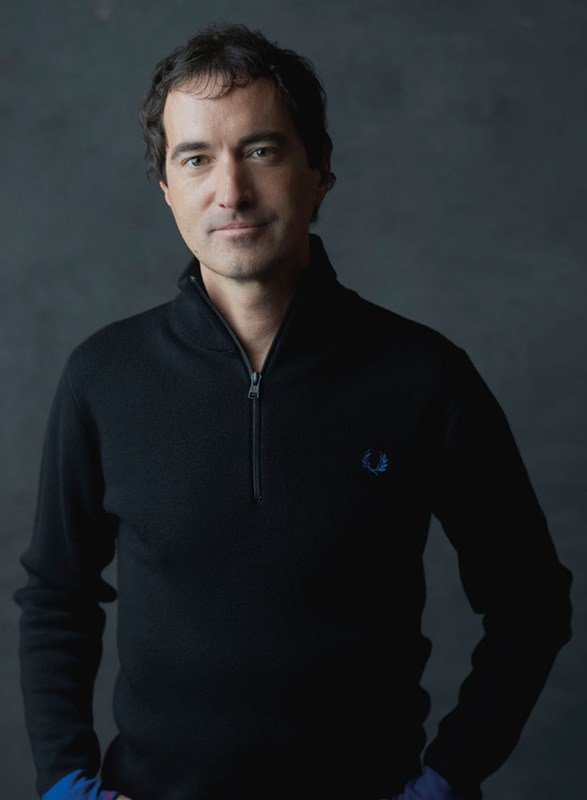 Mason Bates
Mason Bates
On the big screen
‘I felt like this genre of piece – this guide to the orchestra, which has quite a history over many decades – needed an update,’ says Bates. ‘Benjamin Britten's Young Person's Guide is not going anywhere – it's one of the great pieces of the rep – but I felt like we were ready not only for a fresh approach in terms of how the orchestra was explored, but we were ready for a fresh means of telling it.’ Bates is calling from California where it's a bright 1pm, while I'm illuminated by candlelight as I settle in for a late-evening Zoom to accommodate the eight-hour time difference. Surrounded by musical instruments of various varieties, the composer-DJ tells me that seeing orchestras performing under ‘giant screens’ over recent years fuelled the idea for a new guide to the orchestra.
This evolved, combining the intrinsically modern medium with Bates’ love for animation and the ‘special connection’ that exists between music and animated film. Philharmonia Fantastique was born – a piece that can be both performed live by a full orchestra accompanied by the film-in-concert, and watched outside of the concert hall. The full film, due to be released on Apple TV in early November, shows the Chicago Symphony Orchestra performing to a live audience beneath the big screen, with the film-in-concert often zooming to fill the viewer's TV or computer screen. The piece is intended to be presented in four ways: in the ‘concerto slot’ of a concert programme; as the prelude to a ‘film-in-concert’ show; in family concerts; and in education concerts.
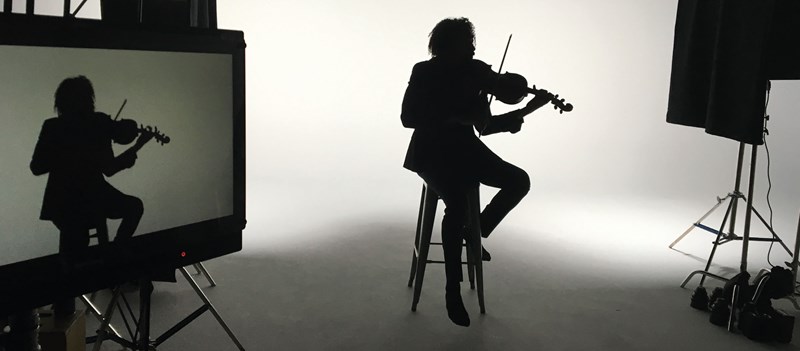
Keith Lawrence, viola, during filming
Showing off the orchestra
Philharmonia Fantastique follows a magical ‘Sprite’ as it journeys to discover the four different ‘tribes’ of the orchestra, darting in and out of instruments to see how valves work, pausing in awe in the distant opening of a flute, the warped interior of which fills the whole screen (see image). ‘I felt that telling this through the eyes of a magical Sprite that can go inside instruments and see how they work would give the piece an interesting creative technology angle, which we haven't seen in other explorations,’ says Bates. As well as refreshing the genre and incorporating technology in a more explicit way, the composer also hopes to do something ‘a little bit bigger’. He continues: ‘I want my kids – who were eight and 10 when I started writing it and are now 10 and 13 – to be as enamoured with this incredible medium as I have always been. It's easy to forget, when you're surrounded by digital mediums all the time, how special the orchestra is. I wanted to show off the fact that the orchestra is this incredible model of different people and different technologies working together.’
This final point is what Bates describes as one of the project's ‘big picture’ aims. Rather than a didactic ‘music education resource’, Philharmonia Fantastique has people at its core: ‘The orchestra is a model of different people coming together, and the basic premise for me was an emotional one,’ says Bates. ‘I really wanted young people to know how exciting this medium is.’
There are two parts to this, says Bates – one related to the different technologies and materials uniting on stage as ‘this single musical organism’, and the other is that the orchestra is ‘alive’. ‘You're really dealing with people, and I find that to be a beautiful part of the experience,’ he says. ‘Everybody is working very carefully on the level of a millisecond to come together, and they can be really different people, with really different beliefs and backgrounds. It's a real model of how we can overcome differences and work together.’
This is powerfully illustrated in the film, visually and aurally (via Bates’ music – there are no words), with the four tribes playing distinct themes throughout and then beginning to play each other's towards the end, which is also reinforced by the animation. Describing the composition experience as a ‘fantastic process’, Bates says that the ‘hardest’ part was figuring out how the instrument families would come together at the end. ‘You have the strings turning into percussion instruments and the brass starting to bend like string instruments – that was quite a bit of work, compositionally, to figure out how I could have these four themes, plus the theme of the Sprite, start to emulate each other and come together at the end.’
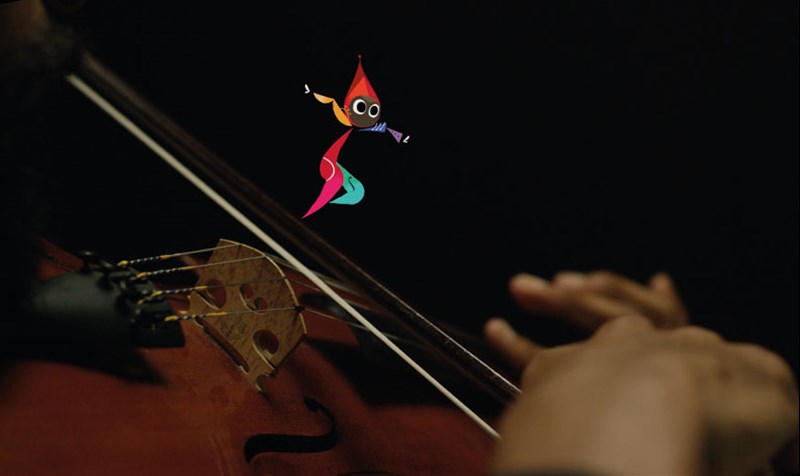
Sprite on a viola bow
A sprite's world
The Sprite – a lithe little thing made up of colourful parts of different instruments – took a year to conceptualise, going through various iterations from ‘really creepy’ to ‘too much like something out of Tinker Bell’, says Bates. ‘I really wanted the Sprite to feel like this little superhero that was endearing and interesting to kids at any age or gender, and I wanted it to feel like this curious, mercurial, magical creature that is something you can relate to, and can also do things you never imagined, like going inside a cello. I didn't understand what a process it would be to go through character design and development.’ Of course, he asked the experts: his children. ‘I think my kids generally like things that they feel they're supposed to grab onto, and that aren't talking down to them,’ says Bates. When he took his children to Skywalker Ranch to watch the film, they said, ‘Wow, that was really fast.’ ‘I was like, good,’ says Bates, ‘– for once we've been able to make something that feels fast to young people.’
When you're watching Philharmonia Fantastique, or even when you're exploring the accompanying Sprite's World website, there's no sense that this is ‘for’ young people. As Bates says, there are many people who don't know what a valve does on a brass instrument, or how a violin can divide its strings into halves, thirds, or quarters. ‘I think even long-time symphony goers haven't really been inside a cello,’ he says. (To film this part the team bought a $45 cello/prop from Walmart and drilled a hole into it). ‘It was also kind of a strategy to make sure that the piece did succeed for kids – there's a fair amount of education material that kids can smell a mile away. I think if you try to make it work for people of all ages, you have a higher likelihood of making it work for the younger demographic.’
As well as appealing to all ages, it is hoped that Philharmonia Fantastique will appeal to people with a range of interests: ‘It's just a basic fact that the instruments of the orchestra are a phenomenal vehicle to discuss not only artistic topics but also scientific ones,’ says the composer. This feels particularly significant in the UK, where arts subjects and STEM subjects continue to be pitted against each other in educational settings, even though the ‘real’ world is never that binary.
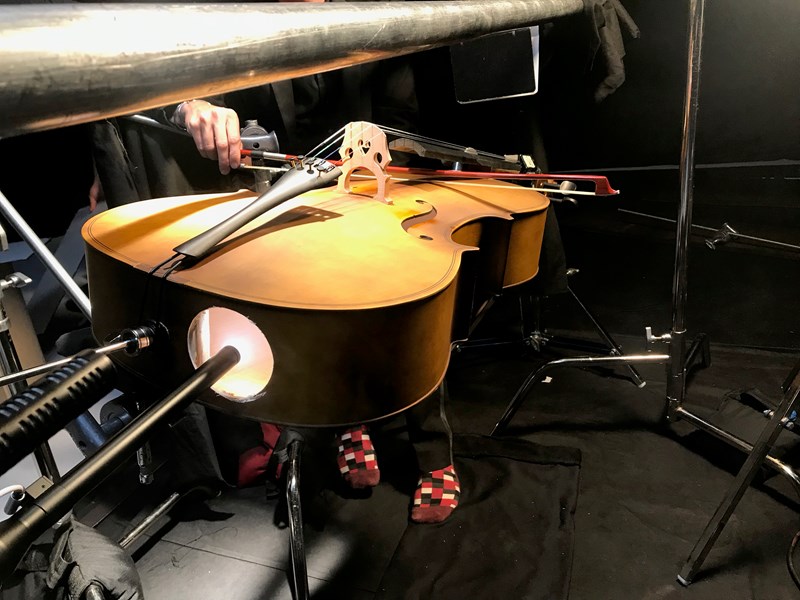 Preparing cello for interior shot
Preparing cello for interior shot
‘It needs to be available’
The project isn't finished. Plans and ideas, Bates tells me, include an immersive VR version of the Sprite that a child could ‘drive’ on an iPad with headphones on, or ‘maybe even a walkthrough exhibit’. They're thinking big, and it's exciting. ‘Our intention is to have this touch as many people as possible. It's a mission-based thing, and it needs to be available.’ Bates hopes that the resources will provide teachers with options ‘presented on a platter’, so that they can make it work for their school and their curriculum, whether in music lessons or not. ‘I think the real key will be partnering with schools,’ he adds.
During the conversation we discuss how, in our efforts to appeal to young people, and to diversify genres, sometimes we become scared of celebrating the orchestra in education settings. Bates simply shrugs: ‘It's always been part of my mission to show that the orchestra can contain multitudes. The orchestra is too cool of a medium to pass up and ignore.’
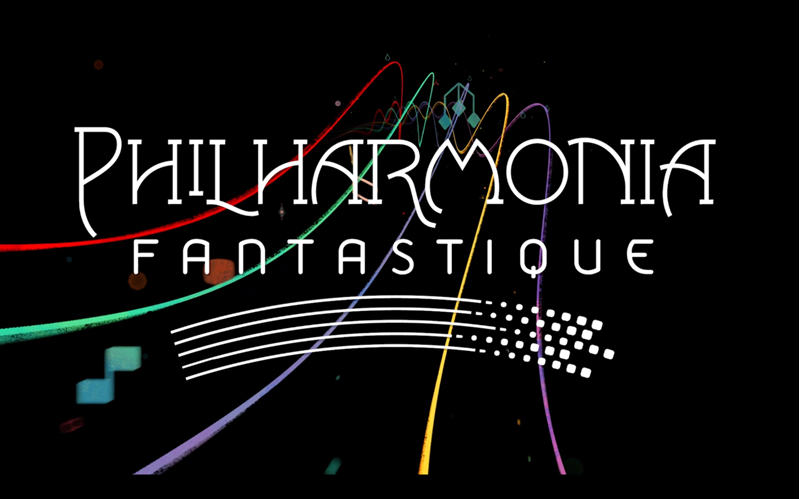
Philharmonia Fantastique will be performed at the Southbank Centre by Aurora Orchestra on 16 April 2023 at 2pm.
The work was commissioned by Chicago Symphony Orchestra, Dallas Symphony Orchestra, National Symphony Orchestra, Pittsburgh Symphony Orchestra, San Francisco Symphony and the American Youth Symphony.
The film will be released on Apple TV and iTunes on 4 November, and the soundtrack is available on Sony Classical. A full education package will be announced in the coming months.
www.masonbates.com/philharmonia-fantastique
www.spritesworld.org/sprites-world


